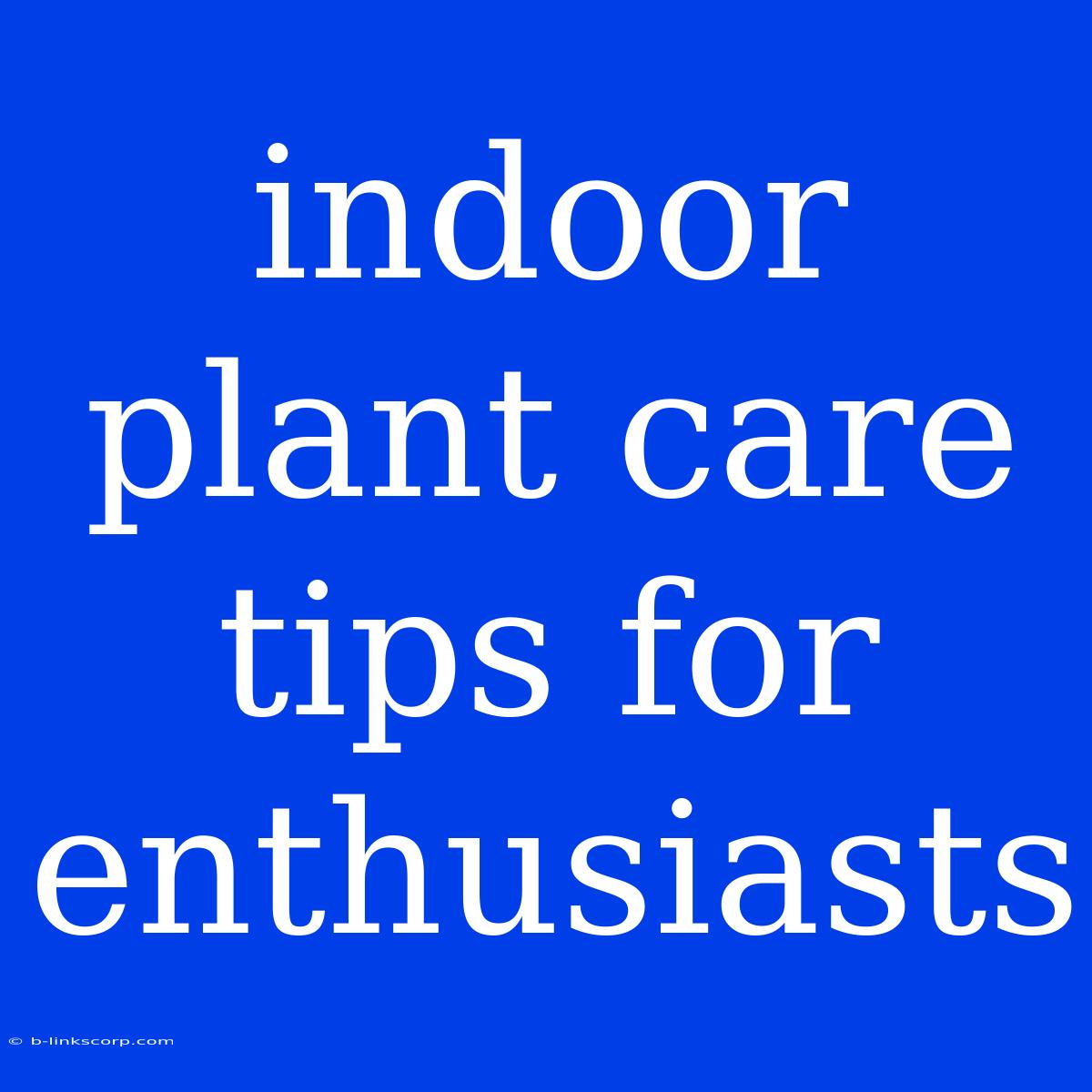Indoor Plant Care Tips for Enthusiasts: A Guide to Thriving Greenery
For plant enthusiasts, bringing the outdoors in is a passion. Indoor plants not only beautify your space but also contribute to a healthier environment. However, keeping these green companions thriving requires a bit more than just watering them occasionally. Here are some essential indoor plant care tips for enthusiasts, ensuring your plants flourish:
1. Choosing the Right Plants:
H2: Knowing your Environment
Start by assessing your home's light conditions. Are your windows sunny, shady, or somewhere in between? Different plants thrive in different lighting situations.
H3: Popular Choices
- Low-light: Snake plants, ZZ plants, Cast iron plants, Peace lilies.
- Medium-light: Pothos, Spider plants, Chinese Evergreen, Philodendron.
- Bright, indirect light: Monstera Deliciosa, Fiddle Leaf Fig, Bird of Paradise, Rubber plant.
H2: Matching Plants to Your Lifestyle
Consider your time commitment. Some plants require more maintenance than others.
H3: Easy Care Options:
- Low-maintenance: Snake plants, ZZ plants, Cast iron plants.
- Moderate care: Pothos, Spider plants, Peace lilies.
- High maintenance: Fiddle Leaf Fig, Monstera Deliciosa, Bird of Paradise.
2. Understanding the Watering Needs:
H2: Avoiding Overwatering
One of the biggest mistakes indoor plant owners make is overwatering. This can lead to root rot and eventually plant death.
H3: The Finger Test:
- Stick your finger about an inch into the soil.
- If it feels dry, it's time to water.
- If it feels damp, wait a few more days.
H2: Other Factors Affecting Watering:
- Pot Size: Smaller pots dry out faster than larger ones.
- Soil Type: Well-draining soil dries out faster than dense soil.
- Season: Plants need more water in summer than in winter.
3. Providing the Right Light:
H2: Light Requirements:
- Low-light plants: Can tolerate low light conditions, but may benefit from some direct light.
- Medium-light plants: Need bright, indirect light, away from direct sunlight.
- High-light plants: Require several hours of direct sunlight daily.
H2: Artificial Light:
If your home doesn't get enough natural light, consider using grow lights.
H3: Choosing the Right Grow Lights:
- LED grow lights are energy-efficient and provide a full spectrum of light.
- Fluorescent grow lights are also effective and are often more affordable.
4. Maintaining Optimal Temperature and Humidity:
H2: Comfortable Temperatures:
Most houseplants prefer temperatures between 65°F and 75°F (18°C and 24°C).
H3: Avoiding Drafts:
Keep your plants away from drafts, which can dry them out.
H2: Humidity Levels:
- Humidifiers: Increase humidity in dry climates.
- Pebble Trays: Fill a tray with pebbles and water, placing the pot on top.
- Grouping Plants: Plants naturally increase humidity when grouped together.
5. Fertilizing for Growth:
H2: The Importance of Nutrients
Indoor plants need nutrients to thrive.
H3: Fertilizing Schedule:
- Fertilize during the growing season (spring and summer).
- Use a balanced liquid fertilizer diluted to half strength.
- Follow the instructions on the fertilizer label.
6. Repotting:
H2: Signs of a Root-Bound Plant:
- Roots growing out of the drainage holes.
- Slow growth.
- Frequent wilting.
H3: Repotting Process:
- Choose a pot that is only slightly larger than the original pot.
- Use fresh potting mix.
- Gently remove the plant from the old pot.
- Place it in the new pot and fill with potting mix.
7. Troubleshooting Problems:
H2: Identifying Issues
- Yellowing leaves: Overwatering, underwatering, nutrient deficiency.
- Brown spots: Too much sun, pests.
- Drooping leaves: Underwatering, lack of humidity, root rot.
H3: Addressing Problems
- Pests: Use a mild insecticidal soap or neem oil.
- Diseases: Remove affected leaves and stems.
- Root rot: Repot the plant in fresh soil and water less frequently.
8. Enjoying Your Greenery:
H2: The Rewards of Plant Care
Caring for indoor plants is not just about keeping them alive; it's about fostering a connection with nature.
H3: Relaxation and Inspiration
Plants bring a sense of peace and tranquility to your home.
H3: Air Purification:
Many plants act as natural air purifiers, improving air quality.
H3: Decorative Value:
Indoor plants add life and color to any space.
Conclusion:
Taking care of indoor plants is a rewarding experience. By following these tips, you can create a vibrant and flourishing indoor oasis. Remember, patience and observation are key to success. Enjoy the journey of nurturing your green companions!

